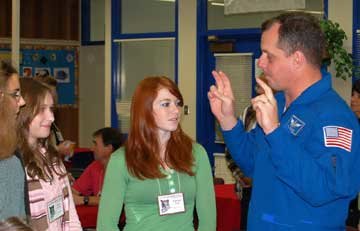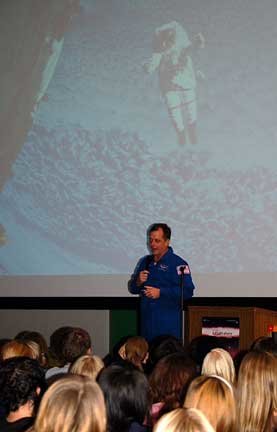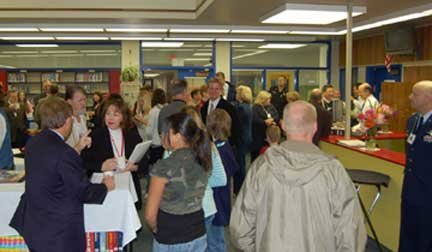 Astronaut TJ Cramer talks to students about his NASA experiences. Photo by Mindi LaRose
Astronaut TJ Cramer talks to students about his NASA experiences. Photo by Mindi LaRose
The Key Peninsula Middle School entered its last year as part of the NASA Explorer program with a variety of exciting opportunities for both students and staff. Several teams throughout the year will participate in activities ranging from teacher leadership conferences to flying in a low-gravity aircraft with a student-designed experiment.
 Astronaut Col. T J Cramer talks about current and future exploration projects at the KPMS NASA assembly. Photo by Mindi LaRose
Astronaut Col. T J Cramer talks about current and future exploration projects at the KPMS NASA assembly. Photo by Mindi LaRose
KPMS became the first NASA Explorer school in Washington state, thanks to the innovation of science teacher Kareen Borders, who applied for the highly competitive grant. As part of the three-year partnership program, which started during the school year 2004-05, the school participated in a variety of NASA-sponsored activities that included frequent visits by astronauts, trips by student or teacher teams to NASA facilities to participate in training and experiments, and cash grants that allowed the school to purchase videoconferencing, robotics and science equipment.
“It has engaged kids in science, technology, engineering and math — there’s been some incredibly high-interest investigations and opportunities for teacher professional development we would not have been able to do without NASA,” Borders said. “Some kids were inspired to explore science and aerospace careers.”
And that is exactly what NASA hopes to achieve — inspire the next generation of explorers and show youngsters some real application of math and science. “It’s important to show (students) the reasons for studying science,” astronaut Col. T.J. Cramer said in an interview before the school’s NASA kick-off assembly at the end of October. “This is the generation that will be doing the future NASA projects.” He said that part of his goal during his presentations at various schools is to inspire the younger generation “that by thinking outside of the box you can progress farther toward your dream.”
 VIP guests in the school’s library before the ceremony. Photo by Mindi LaRose
VIP guests in the school’s library before the ceremony. Photo by Mindi LaRose
Cramer, who works at the Lyndon B. Johnson Space Center in Houston, told the assembly audience, which included local civic leaders and dignitaries: “I’ve seen a lot of schools… and spoke to a lot of schools, and let me tell you right now, this is absolutely the best, inspirational and (full of) enthusiasm.”
In his presentation about NASA, Cramer made a link between science fiction writers and scientific discoveries, pointing out that technology such as radar and the laser “were first described accurately in science fiction.”
“People were thinking for a long time outside the box, ahead, trying to predict what will happen,” he said.
KPMS students have had various opportunities to think outside the box as part of their NASA activities. Several KPMS student experiments were selected by the aerospace agency through a competitive process. The latest, testing the impact of microgravity on the reaction rate between vinegar and soda, will be taken on a DC-9 low-gravity flight by a small team of teachers and students. The two students, PHS senior and KPMS alum John DeLeo, and KPMS/PHS alum Brett Knisely who is now a college sophomore, will not fly on the DC-9, but as the ground crew will do everything else alongside the teachers.
 KPMS students greet the VIP guests arriving for the assembly. Photo by Mindi LaRose
KPMS students greet the VIP guests arriving for the assembly. Photo by Mindi LaRose
“Just getting the school geared up and students involved will be the most exciting part (of the project),” said one of the teachers who will fly in that aircraft, Kathy Tucker, who teaches math at KPMS.
In addition, other teachers will participate in a five-day weather-investigation program in Yellowstone and in national math and science conventions. For aerospace students, robotics, NASA videocasts, and space shuttle pilot panels are among this year’s activities. Later in the year, middle schoolers will also lead NASA activities at the elementary schools.
One of this year’s goals is to create a sustainability plan so the school can continue its space exploration activities once the grant expires at the end of this school year. Borders is on NASA’s national committee that is discussing the idea of a program in which Explorer School “graduates” can become mentor schools. She also continues to look for other opportunities. Recently, she applied and received a grant from the National Gardening Association for a hydroponics activity. KPMS was one of 12 schools selected nationwide.
School Principal Sharon Shaffer, summed up the impact of the Explorer program on the school at the NASA assembly: “The NASA program has provided inspiration for us here… As a school, we continue to shoot for the stars.”
UNDERWRITTEN BY THE FUND FOR NONPROFIT NEWS (NEWSMATCH) AT THE MIAMI FOUNDATION, THE ANGEL GUILD, ADVERTISERS, DONORS AND PEOPLE WHO SUPPORT INDEPENDENT, NONPROFIT LOCAL NEWS